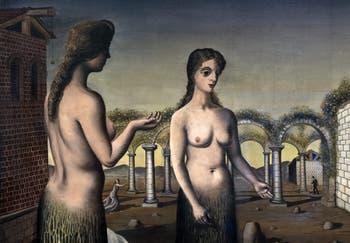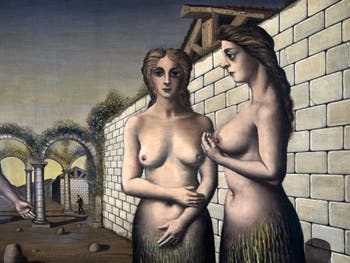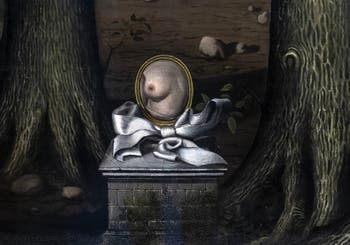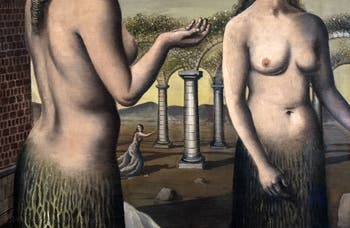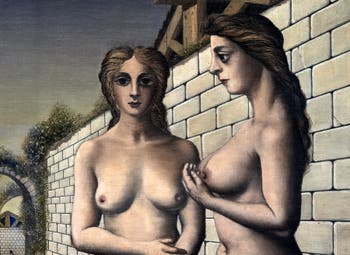Guggenheim Artists | Location | Opening Hours Tickets | Authorizations
Artists Picasso | Pollock | Braque | Calder | Chagall | Dalí | Ernst | Kandinsky | Léger | Magritte | Miró | Modigliani | Brancusi | Brauner | Campigli | Chirico | Delaunay | Delvaux | Duchamp | Fini | Hartung | Kooning | Laurens | Malevich | Man Ray | Masson | Marini | Mondrian | Pegeen | Pevsner | Picabia | Tanguy | Tapies | Twombly | Warhol
Paul Delvaux “The Break of Day” (L’Aurore) at the Peggy Guggenheim Collection in Venice in Italy
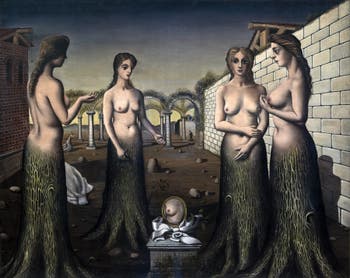
Delvaux, The Break of Day Painting - Oil on Canvas (120 x 150.5 cm) July 1937
Paul Delvaux was born in Belgium in 1897.
He studied architecture at the Royal Academy of Fine Arts in Brussels from 1916 to 1917 and painting from 1918 to 1919.
In 1936, he exhibited with René Magritte at the Palais des Beaux-Arts in Brussels; and later as a unique artist in 1938.
Paul Delvaux's surreal painting, “The Break of Day”, exhibited at the Peggy Guggenheim Collection, was painted between these two exhibitions in 1937.
Just like Magritte, Delvaux takes care of details in his paintings.
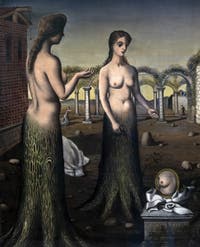
Delvaux, The Break of Day Influenced by Giorgio de Chirico, he takes back his perspectives, long shadows and incorporates classicist elements, including the Greek columns at the bottom of the landscape.
Here woman tree is present in all of Paul Delvaux's paintings, and she is still naked.
Men are also present in his works, but they are in the background, somewhat lost and wearing a bowler hat as at Magritte.
In “The Break of Day”, we find several surrealism myths, including that of the Metamorphoses of Ovid with Daphne and Apollo.
Daphne, we see fleeing in the left bottom of the painting.
Here, the trees turn into women, contrary to Daphne and Apollo's myth, where the beautiful Daphne is transformed into Laurel.
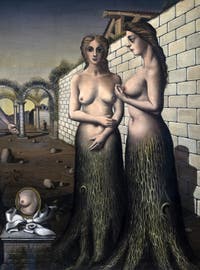
Delvaux, The Break of Day Yet Paul Delvaux himself refuted this mythological origin; what to believe?
The other peculiarity is that the four women are only one, only one model who served for this work, Delvaux's wife, whom he loved.
Four women are “set” in the painting and ignore each other while being one person viewed from various angles and with different gestures, each looking in an equally different direction.
The central mirror is reminiscent of Jan Van Eyck's mirror in his canvas “The Arnolfini Couple”.
A mirror in which one should see the painter looking at the scene, but here we see only one of the women trees presents.
A painter turned into a woman identical to the others, showing the fifth one.
This detail of the mirror will be reappropriated by Marcel Duchamp in his collage “In the way of Delvaux”.
Artists Picasso | Pollock | Braque | Calder | Chagall | Dalí | Ernst | Kandinsky | Léger | Magritte | Miró | Modigliani | Brancusi | Brauner | Campigli | Chirico | Delaunay | Delvaux | Duchamp | Fini | Hartung | Kooning | Laurens | Malevich | Man Ray | Masson | Marini | Mondrian | Pegeen | Pevsner | Picabia | Tanguy | Tapies | Twombly | Warhol
Guggenheim Artists | Location | Opening Hours Tickets | Authorizations
Back to Top of Page


